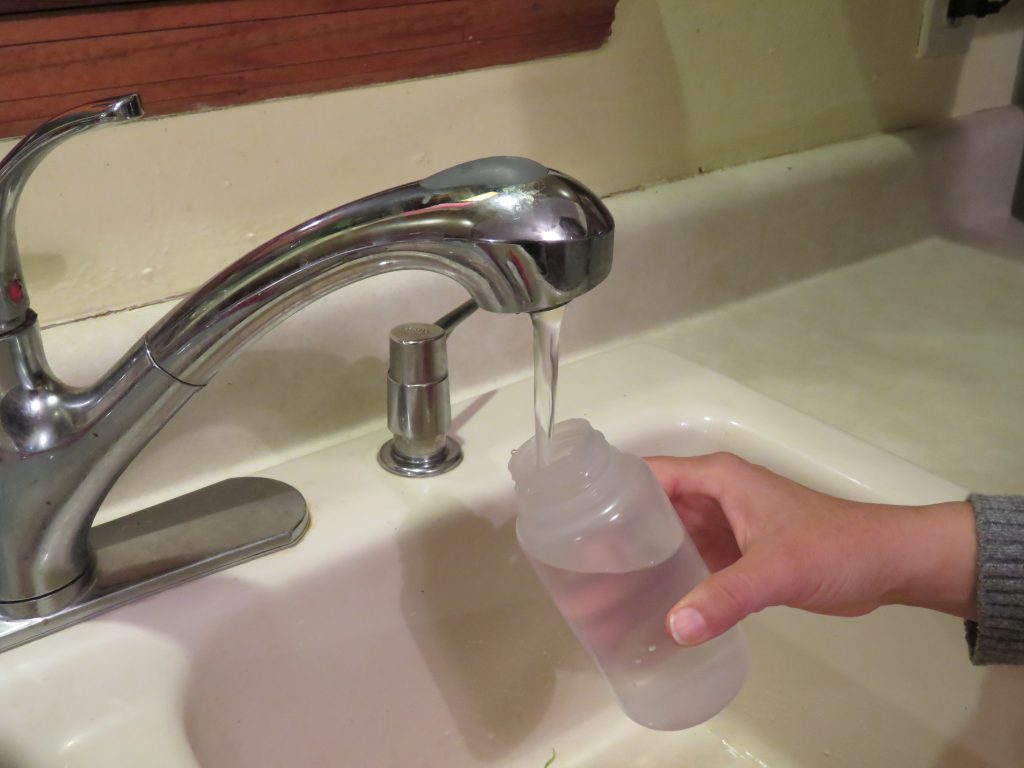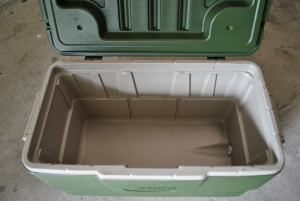
by Amy Mullins, PhD, RDN | Oct 9, 2020
By Matthew Poland and Amy Mullins, MS, RDN
For Floridians, getting enough sunlight during the winter may not be an issue that frequently crosses our sun-kissed minds. However, by spending winter vacation up north or by simply not spending the recommended 10-30 minutes per day outdoors, we could be putting ourselves at risk. In fact, it is estimated that between 20-80% of men and women from the US, Canada and Europe are vitamin D deficient, with rates as high as 45-100% of vitamin D deficiency in some places throughout Asia (1). Even though Florida seems to be as good as it gets for soaking in the sun, a 2005 study of residents of Miami found that between 38-40% were vitamin D deficient (2).
Vitamin D plays a much larger role in our health then we tend to realize. In addition to being a hormone responsible for regulation of bone metabolism, vitamin D has important functions in pregnancy, inflammation, cell growth, neurotransmitter production, immune and neuromuscular function, and glucose metabolism (3). Meanwhile, low vitamin D levels have been associated with increased risk for various diseases including cardiovascular disease, cancer, diabetes, and even an increased risk of mortality (1).

Go outside Photo Source: Matthew Poland
It is well known that sunlight exposure is the major source of vitamin D in our bodies, although some can be absorbed through our diet. However, as we spend less and less time outdoors, our risk of vitamin D deficiency steadily increases. On top of this, there are a variety of factors that can play a role in the ability of an individual to produce vitamin D including skin pigmentation, clothing, sunscreen, and of course where we live. In addition, a likely reason for such a high amount of Miami’s residents being vitamin D deficient is due to the smog levels of larger cities. Air pollution can absorb the UVB rays that our bodies convert into vitamin D, and prevent them from ever reaching us. Plus, in the wintertime, there is less sunlight to be had, which brings into play the next dangerous winter side effect: seasonal affective disorder, appropriately given the acronym, SAD.
While SAD may seem like a northern phenomenon, and it is with up to 9% of Alaska’s residents experiencing SAD compared to Florida’s 1%, it also involves the lack of sunlight during the winter (4). This lack of sunlight interferes with the body’s ability to regulate its circadian rhythm, the 24-hour internal clock that is typically synced with the light-dark cycles of our environment (4). Having shorter days and longer nights in winter is not unique to the north. With some Florida days offering only 10 hours of sunlight and indoor jobs that often consume 8 to 9 hours of our day, there is suddenly limited time to be in the sun (8). Vitamin D has been theorized to play a role in serotonin production, a neurotransmitter responsible for our feelings of well-being and happiness, and the insufficiency or deficiency of vitamin D has also been associated with clinical depressive symptoms (5). In summation, the lack of sunlight during the winter can create depressive symptoms and decreased absorption of vitamin D also leads to further depressive symptoms.
Although this self-perpetuating spiral of doom and gloom may be a bit of a downer, here are a few tips for getting through winter while keeping your vitamin D levels, circadian rhythm, and sanity in check:
- Go outside! Unfortunately, the angle of the sun in the wintertime reduces the availability of ultraviolet sunlight. It is important, however, to spend some time outdoors on sunnier days to allow for vitamin D synthesis, even if it’s not at optimal levels.(6).
- Eat a balanced, healthy diet consisting of a wide variety of foods. Although most foods don’t naturally contain vitamin D, wild-caught salmon and mushrooms being the exceptions, many foods like dairy are fortified with vitamin D (1). However, diet alone has been shown to be insufficient in providing vitamin D to children and adults in the US (7). If through food and sun, your vitamin D levels are not where they need to be, supplementation of around 1000 IUs per day can bring levels back to normal.
- Always talk with your healthcare provider before taking any dietary supplements. Have your vitamin D levels evaluated by your physician. Many people can go throughout life not knowing they are deficient in vitamin D until a broken bone necessitates testing.
So, with winter approaching, keep in mind the importance of being outside and eating well to feel your best as we roll into 2021!
Photo credit: Matthew Poland
Matthew Poland is a Graduate Student in the Department of Food, Nutrition, and Exercise Sciences at Florida State University who is currently working on the Dietetic Internship to become a Registered Dietitian/Nutritionist (RDN).
References:
- Hossein-nezhad, A., & Holick, M. F. (2013). Vitamin D for health: a global perspective. Mayo Clinic proceedings, 88(7), 720–755. https://doi.org/10.1016/j.mayocp.2013.05.011
- Levis S, Gomez A, Jimenez C, et al. Vitamin D deficiency and seasonal variation in an adult South Florida population. J Clin Endocrinol Metab. 2005;90:1557–1562.
- Vitamin D – Fact Sheet for Health Professionals. (2020, September 11). Retrieved September 17, 2020, from https://ods.od.nih.gov/factsheets/VitaminD-HealthProfessional/
- Melrose S. (2015). Seasonal Affective Disorder: An Overview of Assessment and Treatment Approaches. Depression research and treatment, 2015, 178564. https://doi.org/10.1155/2015/178564
- Kerr, D. C., Zava, D. T., Piper, W. T., Saturn, S. R., Frei, B., & Gombart, A. F. (2015). Associations between vitamin D levels and depressive symptoms in healthy young adult women. Psychiatry research, 227(1), 46–51. https://doi.org/10.1016/j.psychres.2015.02.016
- Webb, A. R., Kline, L., & Holick, M. F. (1988). Influence of season and latitude on the cutaneous synthesis of vitamin D3: exposure to winter sunlight in Boston and Edmonton will not promote vitamin D3 synthesis in human skin. The Journal of clinical endocrinology and metabolism, 67(2), 373–378. https://doi.org/10.1210/jcem-67-2-373
- Moore, C., Murphy, M. M., Keast, D. R., & Holick, M. F. (2004). Vitamin D intake in the United States. Journal of the American Dietetic Association, 104(6), 980–983. https://doi.org/10.1016/j.jada.2004.03.028
- Tallahassee, Florida, USA – Sunrise, Sunset, and Daylength, September 2020. (n.d.). Retrieved September 19, 2020, from https://www.timeanddate.com/sun/usa/tallahassee

by Andrea Albertin | Oct 1, 2020
If your private well was damaged or flooded due to a hurricane or other heavy storm activity, your well water may not be safe to drink. Well water should not be used for drinking, cooking purposes, making ice, brushing teeth, or bathing until it is tested by a certified laboratory for total coliform bacteria and E. coli.
Residents should use bottled, boiled, or treated water until their well water has been tested and deemed safe.
- Boiling: To make water safe for drinking, cooking, or washing, bring it to a rolling boil for at least one minute to kill organisms and then allow it to cool.
- Disinfecting with bleach: If boiling isn’t possible, add 1/8 teaspoon or about 8 drops of fresh unscented household bleach (4 to 6% active ingredient) per gallon of water. Stir well and let stand for 30 minutes. If the water is cloudy after 30 minutes, repeat the procedure once.
- Keep treated or boiled water in a closed container to prevent contamination.
NOTE: Use bottled water for mixing infant formula.
Where can you have your well water tested?

Contact your county health department for information on how to have your well water tested. Image: F. Alvarado Arce
Most county health departments accept water samples for testing. Contact your local department for information about what to have your water tested for (they may recommend more than just for bacteria), and how to collect and submit the sample.
Contact information for Florida Health Departments can be found here: County Health Departments – Location Finder
You can also submit samples to a certified commercial lab near you. Contact information for commercial laboratories that are certified by the Florida Department of Health are found here: Laboratories certified by FDOH. This site includes county health department labs, commercial labs, and university labs; you can search by county.
What should you do if your well water sample tests positive for bacteria?
The Florida Department of Health recommends well disinfection if water samples test positive for total coliform bacteria or for both total coliform and E. coli, a type of fecal coliform bacteria.
You can hire a local licensed well operator to disinfect your well, or if you feel comfortable, you can shock chlorinate the well yourself.
You can find information on how to shock chlorinate your well at:
After well disinfection, you will need to have your well water re-tested to make sure it is safe to use. If it tests positive again for total coliform bacteria or both total coliform and E. coli, call a licensed well operator to have the well inspected to get to the root of the problem.
Well Pump and Electrical System Care
If the pump and/or electrical system have been underwater and are not designed to be used underwater, do not turn on the pump. There is a potential for electrical shock or damage to the well or pump. Stay away from the well pump while flooded to avoid electrical shock.
Once the floodwaters have receded and the pump and electrical system have dried, a qualified electrician, well operator/driller, or pump installer should check the wiring system and other well components.
Remember: You should have your well water tested any time:
- A flood occurs and your well is affected
- The color, taste, or odor of your well water changes or you suspect that someone became sick after drinking your well water.
- A new well is drilled or you have had maintenance done on your existing well
- There has been any type of chemical spill (pesticides, fuel, etc.) into or near your well
The Florida Department of Health maintains an excellent website with many resources for private well users: FDOH Private Well Testing and Other Resources includes information on potential contaminants and how to maintain your well to ensure the quality of your well water.

by Angela Hinkle | Sep 15, 2020
Most of us know there is a great deal of cleanup after a disaster hits. But how often do you think about what to clean before disaster strikes?
Here are some helpful cleaning measures you can do before a storm or other calamity so your burden is not so great after.
Outside
Mow the Lawn
If your lawn is mowed low and even now, you won’t have tall grass to trudge through later. Refill any gas cans and/or re-charge any lawnmower batteries after mowing. It will be much easier to pick up and remove any debris that lands on the mown lawn. And you may need to use the gas in the filled can to operate other equipment for the after-cleanup.
Trim, Whack, and Blow
Trim the hedges, whack down those weeds, and blow those leaves now. Otherwise, you may later find yourself with a big mess on top of a big mess.
Bring It In
Bring in any garbage cans, lawn furniture, or other yard items that could make a mess if blown over, broken, or made into dangerous shrapnel.
Inside

Lightning storm. Photo Source: UF/IFAS
Leave No Piles
Make sure there are no dirty dishes in the sink or the dishwasher. Make sure everything is cleaned, dried, and put away. Then, if you lose electricity after the storm or are not sure of the safety of your water, you don’t have to worry about clean plates to eat on, glasses to drink from, or utensils to eat with. And you don’t have a mess to look at or a stink from the sink to deal with.
Clean, dry, and put away all the dirty laundry now. If you lose that all-important electricity later, you won’t have to worry about stepping over piles of clothes or wonder how you’re going to deal with wearing the same dirty clothes over and over again. If you have a generator, you could use that to clean your clothes, but most of the time those generators are best used to keep food safe in the refrigerator or to operate emergency equipment.
Scrub
If your bathroom tub is scrubbed clean now, you can fill it with water for flushing toilets, cleaning, or purifying and using as extra drinking water. You can also take a relaxing, cleansing bath from a hard, dirty day’s work after the storm.
And cleaning a dirty toilet now means you’ll have one less thing to have to deal with later – along with everything else on your to-do list.
Get Rid of It
Make sure the garbage can, recycle bin, and compost container are all emptied. The last thing anyone needs is old piles of trash with new piles of trash added on top.
Been meaning to give away those extra items (knick knacks, doodads, toys, etc.) you don’t use or like anymore? Doing that now makes for a cleaner house as opposed to having more “stuff” in the house, adding to the mess you may have to deal with later.
Clear the Clutter
Pick up papers, bills, tools, and any other important items that may be on various surfaces throughout the house (you may actually want to eat on that dining room table some day). Then organize them together in a safe place. This helps to keep them from getting water damaged or tossed around and you’ll be able to find them later.
Have your emergency kit filled and ready to go in a plastic tub or waterproof container. Make sure everyone in the house knows where it is. For other disaster preparation and recovery resources, go to https://disaster.ifas.ufl.edu/ and/or talk with your county UF/IFAS Extension Agent.
If your home or property are destroyed in a disaster, these measures probably won’t really help much. But if all is not lost and there is just some debris and damage cleanup to be done after a large weather event, the above measures taken before can alleviate a lot of extra stress after. And if there is no disaster, hey, your house is nice and clean. Relax and enjoy it!
Make sure you clean before disaster strikes.

by Judy Corbus | Aug 27, 2020
Eeekkk! A roach! Quick – where’s the bug spray? That seems like a logical way to get rid of the pesky critter, right? But what if the roach is in your kitchen? Or you have pets or small children? Is there a less toxic way to keep pests out of your home?
Integrated Pest Management, or IPM, uses a combination of methods to help you:
- Stop pests
- Inspect and monitor for pests
- Identify pests
- Have a game plan to protect your home
- Know if your plan is working
Pests, like people, need food, water, and shelter to thrive, so if you eliminate one or all these factors, you increase your pest control success. You can use IPM to prevent indoor and outdoor pests and solve existing pest problems.

If you can see light around the door edge, insects can enter. Photo source: UF/IFAS
Exclusion is a major part of prevention in IPM; it prevents outdoor pests from entering.
- Check the weather-stripping around exterior doors and windows – if you can see light, pests can enter. Did you know an American cockroach can enter through a gap the thickness of a quarter?
- Install door sweeps on exterior doors so insects can’t enter under the door – be sure the sweep brushes the floor.
- Patch or replace window and door screens to keep flying insects out.
- Use sealants around doors and windows to fill tiny gaps where pests can enter. It will help to conserve energy, too!
- Cover vent pipe openings, like dryer vents, on your home’s exterior with strong mesh or other covering to keep rodents and other small animals from entering.
Our Habits
We sometimes make it easier for pests to move in and thrive in our home due to our habits. Here are a few easy ways to prevent pests:
- Wash dishes promptly. Pests feast on food particles so wash dishes immediately after meals.
- Quickly clean up grease and spills. Just like dirty dishes, grease and food spills attract pests so clean them as soon as they occur. This also will keep the spill from spreading, saving you cleaning time in the long run.
- Store food items in sealed plastic containers. This keeps pests out and food items fresher for longer.
- Clean on a routine schedule. Regular sweeping, vacuuming, mopping, dusting, and general cleaning removes food sources for pests and creates a healthier indoor living space for you and your family.
- Get rid of clutter. Piles of paper, clothes, and other items can provide a dark, cozy home in which pests can hide and multiply. Organize these areas so your home is less inviting to pests. Cockroach control alone can significantly reduce allergen levels.
- Dispose of recycling frequently. This removes a breeding ground for pests.
- Inspect incoming goods or items before bringing them into your home. This will reduce the risk of “stowaways” entering.
- Use plastic bins for long-term storage. Cockroaches love cardboard boxes and paper bags so transfer items you plan to store for longer than three to six months to plastic storage bins with tight-fitting lids.
Treatment
There are a variety of treatment options for controlling pests.

Use window cleaner, rubbing alcohol, or baby wipes to disrupt ant trails in your home. Photo source: Judy Corbus, UF/IFAS Extension
- Window cleaner, rubbing alcohol, baby wipes: Ants travel in trails to and from their food source, emitting pheromones, or scent trails, to “mark” their path to the food. To disrupt ant trails, spray window cleaner on or apply rubbing alcohol to a paper towel or use baby wipes to wipe the ant trail. This removes the scent trail so the ants cannot find their way back to their food.
- Whole home gel bait: These products come in a syringe-type applicator with formulations for cockroaches and ants. Examine your home carefully to see where these pests are entering and apply a pea-sized dollop of the gel bait at the entry points. The pests eat the bait and return to their nest, where the gel bait eliminates the nest. The gel bait can be used anywhere in and around the house where cockroaches or ants are found and is more effective than treating kitchens and bathrooms only, a common pest control practice. Gel bait works well behind appliances, swtichplates, and outlet covers. Reapply gel bait periodically to keep pests from returning. You may need to rotate brands, as pests can develop immunity over time.
So, the next time you see a bug in your home, consider IPM before you reach for the spray. For more information about integrated pest management for homes, contact your local UF/IFAS Extension office.

by Samantha Kennedy | Aug 19, 2020
A friend of mine recently shared with me a few recipes for what is known as “cooler corn.” As the name implies, it’s a way of cooking a large amount of corn on the cob all at once inside a cooler, thereby saving time and grill and/or stove space.
At first I was intrigued. I had never heard of this cooking method before and my own personal curiosity was piqued. However, as a certified food safety instructor, I was also immediately horrified. As I reviewed several recipes for this “perfect way to make corn for a crowd,” I became increasingly alarmed. There were so many proper food safety practices violated, it nearly turned my stomach.
Cooking food in a cooler is an unsafe cooking method. Coolers are not designed to withstand the high temperatures required for cooking and cannot adequately hold foods at safe temperatures for prolonged periods of time.
For the record: Cooking corn in a cooler is UNSAFE. The safest ways to cook corn are in a stockpot on the stove, in the oven, or on a grill.
Here are the top four reasons this cooking method is not a good food safety practice:

Cooking food in a cooler is an unsafe cooking method. Coolers are not designed to withstand the high temperatures required for cooking and cannot adequately hold foods at safe temperatures for prolonged periods of time. (Photo source: Samantha Kennedy, UF/IFAS Extension)
1. Coolers are not designed to be used for cooking. The plastic used in coolers is not meant to withstand continued exposure to boiling water and will start to degrade over time. The plastic can also be easily scratched or gouged, providing the perfect place for foodborne pathogens such as Salmonella and E.coli to hide and grow. Think of the other things coolers are used for: storing fish or game after fishing or hunting, keeping drinks cold, storing raw meat or poultry for a picnic, etc. There are so many other opportunities to contaminate the cooler before it is used for cooking corn, even thorough cleaning and sanitation may not be enough to eliminate pathogens. Always keep cooking utensils and tools CLEAN to reduce your risk of foodborne illness.
But what about the boiling water? Won’t that kill any pathogens? Well, yes and no. See #4 below.
And NO, having a cooler dedicated only to cooking corn will not solve all the problems stated above. The bottom line is COOLERS ARE NOT SAFE TO COOK FOOD IN.
2. One of the conveniences of this method, as celebrated in the various recipes, is that people can just reach into the cooler and grab a perfectly cooked ear or two whenever the mood strikes. Allowing people to reach in and grab food like this – especially with their bare hands – is a very unsafe practice. People may forget to wash their hands properly before reaching in, thereby adding dirt and bacteria to the water and thus the food. This type of “germ-sharing” is called cross-contamination and is one of the leading causes of foodborne illness. Always keep things SEPARATE. This includes keeping raw food separate from cooked food, using separate utensils for each food, and reducing or eliminating bare hand contact with food.
3. Stacking dozens of ears of corn in a container and submerging them in boiling water does not ensure that all of the corn will be cooked evenly. The ones in the middle may not be cooked all the way through and there may also be temperature fluctuations in different areas of the cooler because of the way the food is stacked. There may be hot, warm, and cool spots, which can lower the overall temperature to an unsafe level and promote the growth of pathogens. Always COOK foods to the proper minimum internal temperature. In the case of corn, this is 135 degrees F. This can be measured by inserting a properly calibrated food thermometer between two cooked ears of corn and waiting until the needle stops moving.
4. One blog post about the wonders of Cooler Corn stated, “You can leave the corn in there for quite a while after it’s done cooking to keep the ears warm. Since the temperature naturally drops over time, the corn doesn’t get mushy.” When I read this, my mind screamed, “DANGER!” in flashing red letters.
Boiling water is a good sanitizer. However, a lot of what makes it effective for killing pathogens has to do with proper contact time with surfaces AT THE APPROPRIATE TEMPERATURE. Most coolers are not designed to keep boiling water that hot (212 degrees F) for any significant period of time. Even quality coolers will not hold the temperature long enough to ensure proper sanitation and elimination of pathogens.
One of the most important food safety principles is keeping cold foods cold and hot foods hot. To ensure the safety of food, it is important to keep cold foods below 41 degrees F and hot foods above 135 degrees F.
Now think about ears of corn submerged in water for a prolonged period of time, as the water slowly cools. After a while, that water will no longer be able to keep those ears of corn above 135 degrees F. They will basically be sitting in a soup of tepid water at the most favorable temperature for pathogens to grow. The longer the corn sits in that water, the higher the risk of foodborne illness. Always properly CHILL foods to keep them at a safe temperature, below 41 degrees F. The flip side of this coin is to also ensure hot food stays hot, above 135 degrees F.
Cooking for large groups can be a challenge, especially when kitchen space is limited. (Check out the UF/IFAS Extension fact sheet “Food Safety at Tailgating” for more food safety tips when cooking out.) However, it is never a good idea to sacrifice food safety for convenience. Always follow proper food safety practices, no matter the situation, and remember the 4 principles of safe food: CLEAN. SEPARATE. COOK. CHILL.
UF/IFAS in an Equal Opportunity Institution.

by Angela Hinkle | Aug 10, 2020
You may be spending more time creating and experimenting in your kitchen these days. But are you taking the time to clean and enjoy the beauty of the kitchen when you’re not making those new culinary masterpieces? Here are 11 super simple kitchen cleanups that can take away the stresses caused by kitchen grime, stink, and clutter.
That’s Dirty!
- Dust and Cover
For space between upper cabinets and the ceiling, begin by using a duster (and soapy sponge if needed) to get rid of all those dust bunnies. Then lay down wax paper (which holds the dust) or newspaper, paper grocery bags, or parchment paper. Then you can just lift the old paper and put down new a few times of year without having to clean years of dust and grime by hand. You may want to start with this because dust may fall from the top. Then work your way down to the rest of the kitchen.
- Clean the Microwave
Add about one cup of water to a large microwave-safe bowl. Cut a lemon in half. Squeeze the lemon juice into the bowl then add the lemon halves too. Microwave on high for about 2 minutes until the liquid boils and the window steams up. Don’t open the door yet; let the bowl sit for about 5-10 minutes. The steam loosens the gunk. Then it’s just an easy wipe down with a sponge inside and out.
- Wipe Down Surfaces
Wipe cabinet shelves and doors, counter tops, and trashcans with warm soapy water. Use the rough side of a double-sided non-scratch sponge for stuck-on areas and the softer side for crumbs and easier messes. You can also disinfect these surfaces with a spray bottle filled with a solution of one tablespoon bleach to one quart water, using paper towels to wipe dry.

Ever Cleaned?
Photo: A. Hinkle
- Scrub a Stove-top

Clean/ready to cook.
Photo: A. Hinkle
First, wipe down with warm soapy water. Put half a cup of baking soda in a bowl. Then slowly pour in hydrogen peroxide, mixing until it becomes a thin paste. Pour a little paste on the stubborn spots and rub with a heavy-duty paper towel or rag. The stains should come right off. For stubborn stains, pour a bit more of the paste onto the stuck-on stain and let it soak for about 10 minutes. Then scrub, scrub, scrub some more until the stove-top is completely clean.
(Check manufacturer’s directions for smooth top stoves.)
- Wash the Refrigerator
Take out shelves, drawers, and other removable parts of your refrigerator and freezer and wash with hot water and dish soap – just as if they were dishes. Wash the inside walls and door compartments of the refrigerator and freezer with a solution of 2 tablespoons baking soda and 4 cups warm water to clean and reduce any strong odors. Rinse with clear warm water and dry with a soft cloth. Wipe off all jars and dishes as you replace them in the refrigerator.
Wash the outside of the refrigerator and freezer with hot soapy water, rinse, and dry. Don’t forget the door gaskets – sticky gaskets can cause air leaks, using more energy over time.
That Stinks!
- The Garbage Can
Sprinkle baking soda into the bottom of the trash bag to help keep the shudder-inducing smellies away and/or add a cotton ball soaked in essential oils to add a nice scent.
- The Stinky Sink
First, run hot water down the drain. Follow that with a cup of baking soda. Finish off with a cup of lemon juice. This fizzy reaction is fun to do with the kids.
- That Refrigerator Smell
Placing an open box of baking soda on a shelf in the refrigerator gets rid of most smells. If your unit has a pan or plastic tray on the very bottom to collect the condensation or defrost water, remove and clean it once or twice a year. Dust and moisture in this pan can lead to mold growth and cause health problems for persons with allergies. It also can develop an unpleasant odor. Check your care manual for the location of the pan.
That’s Got to Go!
- Food – Organize, Keep, Toss
Go through your refrigerator, freezer, and pantry and throw away anything that is expired, moldy, or you have no idea what it is. (To learn more about Use-By, Sell-By, and Best-By dates on food packages, check out Understanding Date Labels.) FIFO (First In First Out) your pantry foods by placing the older foods at the front and newer foods in the back. This way, you use up the foods that will expire first. Throw away any foods with freezer burn.
- Herbalicious…or Not
Toss out any herb or spice containers that are past their best-if-used-by date. Herbs and spices begin to quickly lose their wonderful tastes and aromas after this date. If it has no date and you have no idea how long you’ve had it, best bet is to throw it away.

That Kitchen Drawer
Photo Source: A. Hinkle
- That Drawer
Where is that ladle? I know I put it in this drawer. Why is the kitchen tool I want to use always at the bottom of the utensil (or junk) drawer? And why do I have five corkscrews when I don’t even drink wine? Help beat these frustrating dilemmas. De-clutter and organize this drawer. Start by taking everything out – yes, everything. Pick out things you never use. If you’ve had a melon baller for 10 years and used it once nine years ago, put it in a giveaway pile. Put four of the five corkscrews in that pile too. Throw away anything that’s broken or unusable. Wipe out the drawer using a sponge and warm soapy water or disinfectant wipes. Refill the drawer starting in the bottom/back with those tools you don’t use as often. Work your way forward and up with the tools you use most often. Ah, so much better now, and from now on.
Try tackling two or three of these tips a week. You can complete the whole list in one month. Your kitchen will be cleaner and more comfortable, and you can be less stressed and happier.















